Scenario Manager in Excel is your invaluable tool for comprehensive data analysis and decision-making. This feature allows you to explore multiple ‘what-if’ scenarios, providing insights into various possibilities and outcomes. Whether you’re dealing with financial projections, budgeting, inventory management, or any other complex data analysis, ‘Scenario Manager in Excel’ empowers you to make informed choices and optimize your strategies. Embrace the power of scenario modeling to navigate uncertainties, plan effectively, and stay ahead in your data-driven endeavors. With ‘Scenario Manager in Excel,’ you’re not just analyzing data; you’re transforming it into actionable insights that drive success.
This Tutorial Covers:
- What is Scenario Manager in Excel
- How to Use Scenario Manager Analysis Tool in Excel
- Scenario Manager in Excel – Example 1
- How to Create a Summary Report in Excel
- Scenario Manager in Excel Example 2: Take the below data and create new scenarios
- Scenario Manager in Excel – Example 1
1. What is Scenario Manager in Excel?
- The three what-if-analysis tools that are integrated into Excel include the scenario planner. Simply stated, you can observe the effects of altering the input values without altering the data itself. You now enter values that must change in order to accomplish a particular objective, much like a Data Table in Excel.
- Excel’s scenario manager lets you alter or replace the input numbers for numerous cells (maximum up to 32). As a result, you can simultaneously view the outcomes of various input values or situations.
- For instance: What if I reduced the cost of my trip each month? What will my savings be? We can save situations here and use them with just a mouse click.
2. How to Use Scenario Manager Analysis Tool in Excel?
An Excel what-if analysis tool that works with various situations is called Scenario Manager. It employs a set of ranges that have an effect on a particular outcome. Therefore, based on the values present in the range that influence the outcome, we can use it to create various situations, such as bad and medium.
Excel Scenario Manager option is very intuitive and straightforward to use. Let’s use some examples to better grasp how the scenario manager tool in Excel functions.
- Scenario Manager in Excel – Example 1
Your family’s monthly budget might serve as an easy illustration. Spending on things like food, shopping, eating out, etc. will be monitored to see how it affects your total budget.
Consider the following table, which lists your list of expenditures and sources of income.
You can see your total income in cell B7. You can find the month’s overall expenses in cell B18. The total income remaining is shown in cell B20.
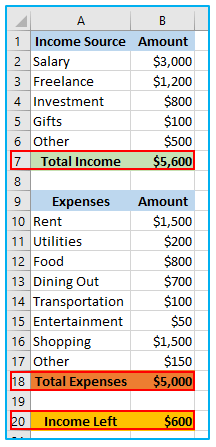
After all expenditures, you only have $600 left over. Therefore, cutting your expenses would help you save more money for the future.
How to use Scenario Manager in Excel is in below:
Step 1: Click the Data option in Excel’s top-left corner. Navigate to the “Data Tools” section on the “Data” menu. Select “Scenario Manager” in Excel by clicking the “What-If-Analysis” item and choosing it from the drop-down selection.

Step 2: The dialog box will appear when you select the “Scenario Manager” as shown below. You must develop a new scenario. Therefore, press the “Add” option.
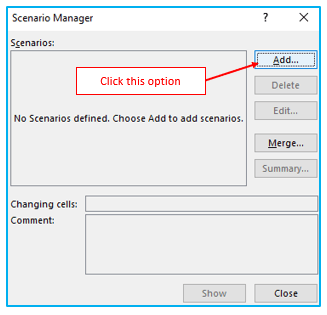
Step 3: The “Add” button will bring up the dialog window below. It displays cell E5 by default, indicating that this is the primary cell. In the “Scenario name” box, type Actual Budget.
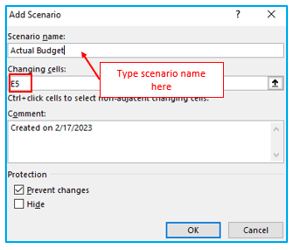
Step 4: You must now specify which columns in your Excel sheet will change. The first scenario won’t alter a thing because this is my actual monthly budget. However, we still need to identify which cells will change.
Try to cut back on your food, dining out and shopping expenses now. Cells B12, B13 and B16, respectively, contain these. The new scenario dialog box should now appear as shown. After that, Press “OK.”
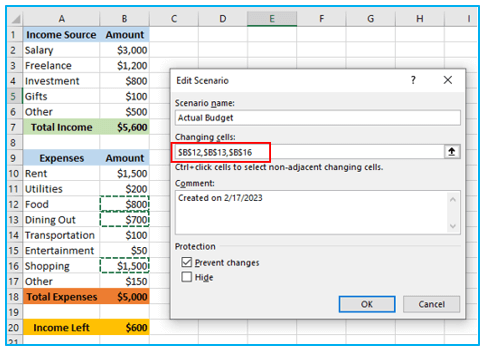
Step 5: You will be asked for some numbers by Excel. Click “OK” because we don’t want this scenario to alter.
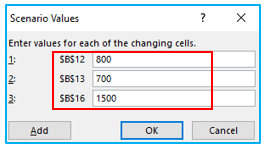
Step 6: You will now be returned to the scenario editor window. The box will now appear as shown.
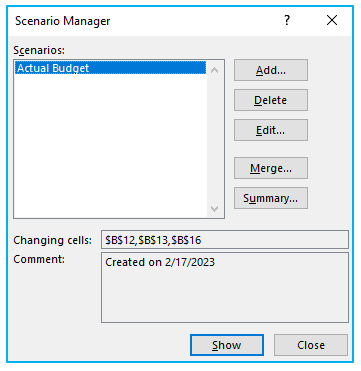
One scenario is now finished and over. Make up a second situation where you have to alter your food expenses and shopping expenses.
Step 7: Give “Plan 2” as the “Scenario Name” by clicking the Add option. B12, B13 and B16 will perform “Changing cells” (food, dining out and shopping expenses).
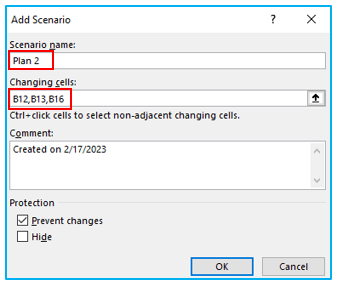
Step 8: The “Scenario Values” dialog window now reappears below. We want to alter the numbers this time. Insert the values shown in the illustration below:
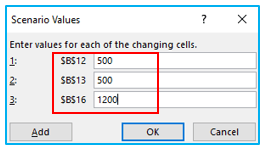
Step 9: These are the updated numbers for Plan 2, our newest scenario. Press “OK.” You are back in the Scenario Manager interface at this point. The Actual Budget and Plan 2 plans are now the names of two scenarios.
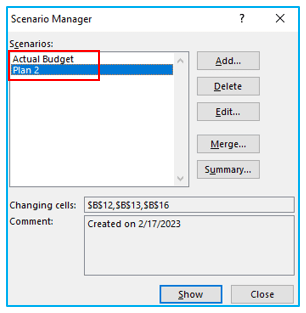
Step 10: To add a scenario, click the Add button and call it “Plan 3”. B12, B13 and B16 will be “Changing cells” (food, dining out and shopping expenses).
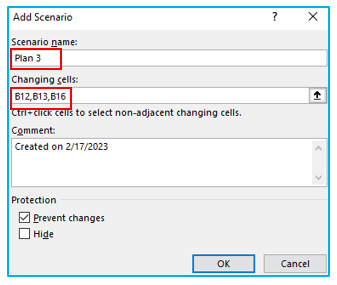
Step 11: The “Scenario Values” dialog window now reappears below. We do want to alter the numbers this time. Insert the values shown in the illustration below:
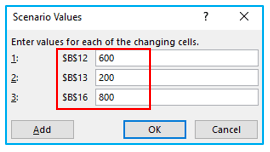
Step 12: These are the updated numbers for Plan 3, our newest scenario. Press “OK.” You’re back in the “Scenario Manager” interface at this point. The three options you have now are Actual Budget, Plan 2, and Plan 3.
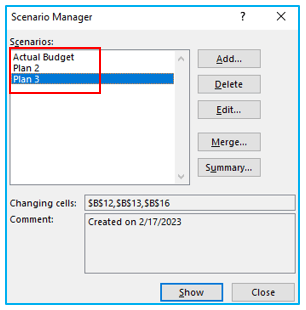
We have our Actual Budget, Plan 2, and Plan 3 as you can see. Then, pick “Plan 2” and press the “Show” button at the bottom. We will calculate the new budget as the numbers in your Excel sheet change. What it appears like is depicted in the image below.
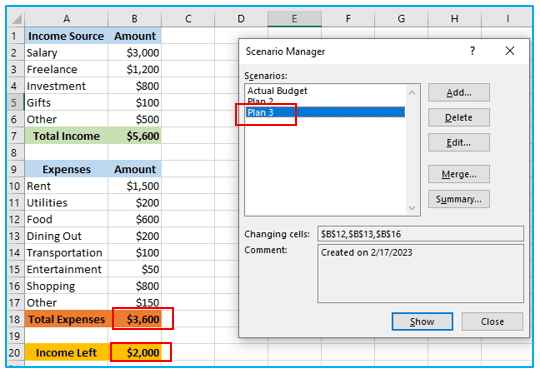
To see the changes, click the Show button and the Actual Budget button. It will show the initial values.
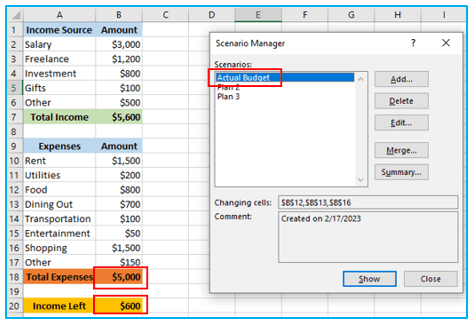
To examine the modifications, repeat the process for “Plan 2.”
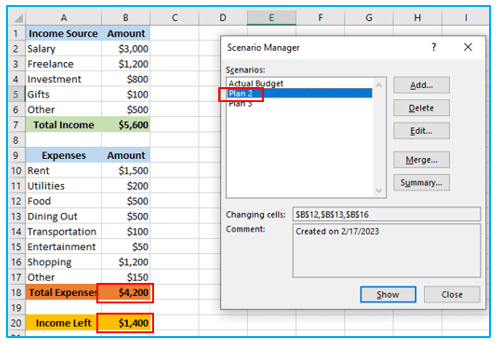
Therefore, the scenario manager in Excel enables you to establish various values and recognize key changes.
- How to Create a Summary Report in Excel?
We can use this scenario manager to add various situations and then generate a summary report in Excel.
Use the steps below to generate a summary report in Excel:
Step 1: Click the Data option in Excel’s top-left corner. Navigate to the “Data Tools” section on the “Data” menu. Select “Scenario Manager” in Excel by clicking the “What-If-Analysis” item and choosing it from the drop-down selection.

Step 2: The dialog box will appear when you select the “Scenario Manager” as shown below. Next, select Summary.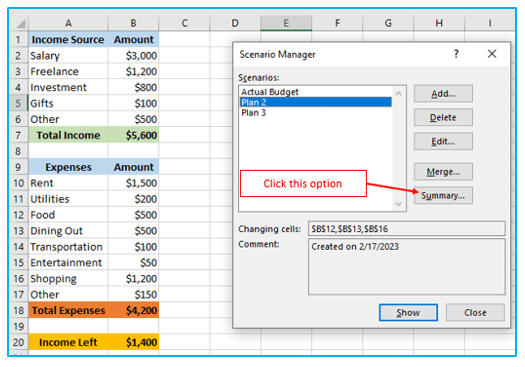
Step 3: To generate the summary report in Excel, click “OK.”
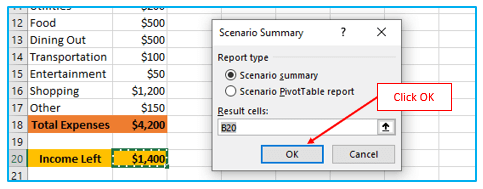
As seen in the below picture, it will produce the summary in the new sheet.
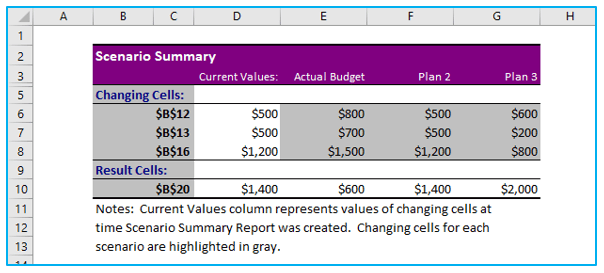
- It displays how savings fluctuate in three distinct scenarios. Savings in the first case were $600. Due to expense reductions in the food, dining out, and shopping sections, savings are increased to $1,400 in the second scenario. Finally, the third scenario depicts the alternative scenario.
- Okay, we just practiced using a basic family budget planner. It appears clear enough to comprehend. Maybe this will persuade your family to change their way of living.
- Excel’s scenario manager is a fantastic instrument for sensitivity analysis. To compare one plan with another and choose the best alternate plan for a better result, you can quickly make the summary report in Excel.
- Scenario Manager in Excel Example 2: Take the below data and create new scenarios
Make up new situations using the data in the table below.
- “If Operating Cost Drop 10%,”
- “If Operating Cost Drop 15%,”
- “If the Unit Amount rises by five.”
Cell B4’s formula is =B2*B3, and cell B11’s formula is =B4-B9.
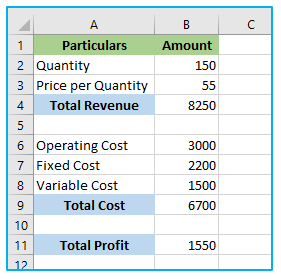
Furthermore, your scenarios will approach the one below.

Application of Scenario Manager in Excel
- Financial Projections:
- Create scenarios to project financial outcomes based on different assumptions, such as revenue growth rates or expense changes.
- Budget Variance Analysis:
- Analyze budget scenarios to assess the impact of various expense or revenue changes on your financial plan.
- Inventory Management:
- Model different inventory scenarios to optimize stock levels and anticipate reorder points.
- Sales Forecasting:
- Forecast sales under different market conditions or pricing strategies to make informed decisions.
- Resource Planning:
- Plan resource allocation scenarios for projects, considering different team sizes, timelines, and workloads.
- Product Pricing:
- Determine optimal pricing strategies by comparing scenarios with varying price points and demand levels.
Scenario Manager in Excel provides a structured way to explore and compare alternative data scenarios, helping you make data-driven decisions and improve your planning and analysis processes.
For ready-to-use Dashboard Templates:
